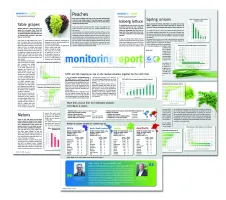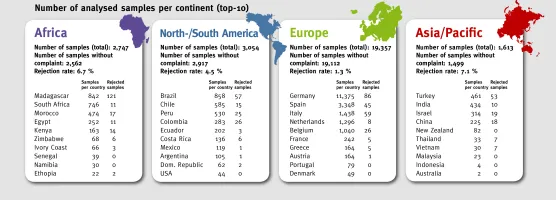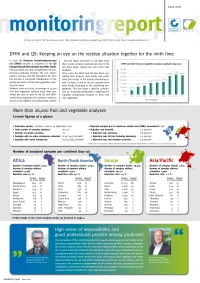QS and DFHV present 9th monitoring report at the 2018 Fruit Logistica
In the broad analysis spectrum of the monitoring programmes from both the QS Fachgesellschaft Obst, Gemüse, Kartoffeln GmbH (QS) and the Deutsche Fruchthandelsverband e. V. (DFHV), 26,771 fruit and vegetable samples from 73 countries were jointly evaluated. The results are more than impressive and show the reliable work of producers and marketers of fresh fruit and vegetables. 97.5 percent of all samples were below the legally required maximum residue levels (MRL) for plant protection products. 41.6 percent of all samples were completely free of any residues – a remarkable increase of 5 percentage points compared to the previous year.
Rejection rate for products from non-EU countries decreased
With a share of 0.8 percent, the rejection rate for products from Germany is at a similarly low level as last year. The same can be said for products from other European countries, which show an average rejection rate of 2.0 percent. Particularly pleasing is the decreased rejection rate for products from non-EU countries from 6.7 percent to 5.9 percent. Especially the rejection rate within the product group of exotic fruits dropped by 2.2 percentage points. An exceedance of the maximum residue levels for fosetyl-aluminium in papaya, passion fruit and sweet cherries was determined particularly often. In this context, the various sources should be noted. It is not always attributable to the active application of fosetyl-aluminium (see page 4 in the monitoring report).
Numerous legal changes of maximum residue levels
A thematic focus of the monitoring report is on the broad number of newly issued EU regulations, which in the past two years concerned the maximum residue levels of a total of 157 active substances and which posed growing challenges to those involved in the supply chain. For instance, this includes thiabendazole, whose maximum residue level in mangoes is no longer 5 but 0.01 mg/kg as of 1 January 2018. Furthermore, kohlrabi leaves have been classified under the crop group kale since 1 January 2017, which means that in part considerably lower maximum residue levels apply to the leaves than the tuber.
The new monitoring report is published in time for the 2018 Fruit Logistica and is available for download on the websites of QS (www.q-s.de/en/) and the DFHV (www.dfhv.de).
Monitoring Report 2018 - View and download here:
Photos
High-quality pictures for download
Picture Credit: QS Qualität und Sicherheit GmbH / www.q-s.de
Monitoring Report Fruit, Vegetables, Potatoes 2018 - Title
Monitoring Report Fruit, Vegetables, Potatoes 2018
Monitoring Report Fruit, Vegetables, Potatoes 2018 - Number of analysed samples per country






